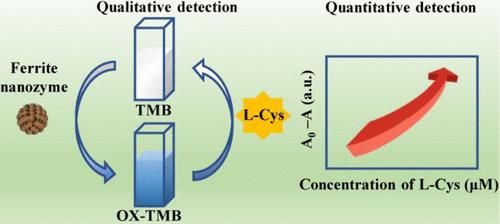Our official English website, www.x-mol.net, welcomes your
feedback! (Note: you will need to create a separate account there.)
Mechanism and Application of Surface-Charged Ferrite Nanozyme-Based Biosensor toward Colorimetric Detection of l-Cysteine
Langmuir ( IF 3.7 ) Pub Date : 2022-06-24 , DOI: 10.1021/acs.langmuir.2c00657 Hongjiao Wu 1, 2 , Jun Liu 1 , Zhuoyu Chen 1 , Pengcheng Lin 1 , Wentao Ou 1 , Zian Wang 1 , Wei Xiao 2 , Ying Chen 1 , Donglin Cao 2
Langmuir ( IF 3.7 ) Pub Date : 2022-06-24 , DOI: 10.1021/acs.langmuir.2c00657 Hongjiao Wu 1, 2 , Jun Liu 1 , Zhuoyu Chen 1 , Pengcheng Lin 1 , Wentao Ou 1 , Zian Wang 1 , Wei Xiao 2 , Ying Chen 1 , Donglin Cao 2
Affiliation

|
Peroxidase-like nanozymes with robust catalytic capacity and detection specificity have been proposed as substitutes to natural peroxidases in biochemical sensing. However, the catalytic activity enhancement, detection mechanism, and application of nanozyme-based biosensors toward l-cysteine (l-Cys) detection still remain significant challenges. In this work, a doped ferrite nanozyme with well-defined structure and surface charges is fabricated by a two-step method of continuous flow coprecipitation and high-temperature annealing. The resulted ferrite nanozyme possesses an average size of 54.5 nm and a zeta-potential of 6.45 mV. A high-performance biosensor is manufactured based on the peroxidase-like catalytic feature of the doped ferrite. The ferrite nanozyme can oxidize the 3,3′,5,5′-tetramethylbenzidine (TMB) with the assistance of H2O2 because of the instinctive capacity to decompose H2O2 into ·OH. The Michaelis–Menten constants (0.0911 mM for TMB, 0.140 mM for H2O2) of the ferrite nanozyme are significantly smaller than those of horseradish peroxidase. A reliable colorimetric method is established to selectively analyze l-Cys via a facile mixing-and-detecting methodology. The detection limit and linear range are 0.119 μM and 0.2–20 μM, respectively. Taking the merits of the ferrite nanozyme-based biosensors, the l-Cys level in the human serum can be qualitatively detected. It can be anticipated that the surface-charged ferrite nanozyme shows great application prospects in the fields of bioanalytical chemistry and point-of-care testing.
中文翻译:

表面带电铁氧体纳米酶生物传感器比色检测l-半胱氨酸的机理及应用
已提出具有强大催化能力和检测特异性的类过氧化物酶纳米酶作为生化传感中天然过氧化物酶的替代品。然而,基于纳米酶的生物传感器对l-半胱氨酸(l-半胱氨酸)的催化活性增强、检测机制和应用-Cys) 检测仍然是重大挑战。在这项工作中,通过连续流动共沉淀和高温退火的两步法制备了具有明确结构和表面电荷的掺杂铁氧体纳米酶。得到的铁氧体纳米酶的平均尺寸为 54.5 nm,zeta 电位为 6.45 mV。基于掺杂铁氧体的类过氧化物酶催化特性制造了一种高性能生物传感器。铁氧体纳米酶具有将H 2 O 2 分解成·OH的本能能力,可以在H 2 O 2 的帮助下氧化3,3',5,5'-四甲基联苯胺( TMB ) 。米氏常数(TMB 为 0.0911 mM,H 2 O 2为 0.140 mM) 的铁氧体纳米酶明显小于辣根过氧化物酶。建立了一种可靠的比色法,通过简便的混合和检测方法选择性地分析l -Cys。检测限和线性范围分别为 0.119 μM 和 0.2–20 μM。利用基于铁氧体纳米酶的生物传感器的优点,可以定性检测人血清中的l -Cys水平。可以预见,表面带电的铁氧体纳米酶在生物分析化学和即时检测领域显示出巨大的应用前景。
更新日期:2022-06-24
中文翻译:

表面带电铁氧体纳米酶生物传感器比色检测l-半胱氨酸的机理及应用
已提出具有强大催化能力和检测特异性的类过氧化物酶纳米酶作为生化传感中天然过氧化物酶的替代品。然而,基于纳米酶的生物传感器对l-半胱氨酸(l-半胱氨酸)的催化活性增强、检测机制和应用-Cys) 检测仍然是重大挑战。在这项工作中,通过连续流动共沉淀和高温退火的两步法制备了具有明确结构和表面电荷的掺杂铁氧体纳米酶。得到的铁氧体纳米酶的平均尺寸为 54.5 nm,zeta 电位为 6.45 mV。基于掺杂铁氧体的类过氧化物酶催化特性制造了一种高性能生物传感器。铁氧体纳米酶具有将H 2 O 2 分解成·OH的本能能力,可以在H 2 O 2 的帮助下氧化3,3',5,5'-四甲基联苯胺( TMB ) 。米氏常数(TMB 为 0.0911 mM,H 2 O 2为 0.140 mM) 的铁氧体纳米酶明显小于辣根过氧化物酶。建立了一种可靠的比色法,通过简便的混合和检测方法选择性地分析l -Cys。检测限和线性范围分别为 0.119 μM 和 0.2–20 μM。利用基于铁氧体纳米酶的生物传感器的优点,可以定性检测人血清中的l -Cys水平。可以预见,表面带电的铁氧体纳米酶在生物分析化学和即时检测领域显示出巨大的应用前景。











































 京公网安备 11010802027423号
京公网安备 11010802027423号